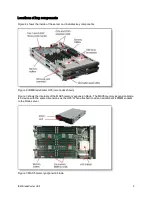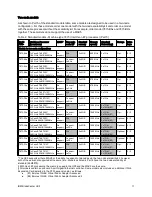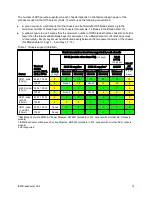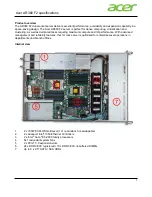
IBM BladeCenter HX5
3
The HX5 scales to 12 I/O ports on a single-wide blade with integrated Gigabit Ethernet and optional
Virtual Fabric expansion cards, offering the choice of Ethernet, Fibre Channel, SAS, iSCSI, and FCoE
connectivity.
Availability and serviceability
The BladeCenter HX5 provides many features to simplify serviceability and increase system uptime:
Support for machine check architecture (MCA) recovery, a feature of the Intel Xeon processor E7
family, which enables the handling of system errors that otherwise require the operating system to be
halted. SAP HANA is one of the first application which leverages the MCA recovery to handle system
errors in order to prevent the application from being terminated in case of a system error.
Extensive memory protection with IBM Chipkill, and, with DIMMs containing x4 DRAM modules,
Redundant Bit Steering (RBS) (also known as Double Device Data Correction or DDDC) is also
supported. The combination of IBM Chipkill and RBS provides very robust memory protection that
sustains to two sequential memory DRAM chip failures without affecting overall system performance.
Redundant CPU-to-I/O hub interconnect links provide ability to self-recover from CPU failure. If
primary CPU fails then eX5 systems can use the second CPU to boot the OS as they still have
access to the integrated I/O devices because of redundant links between CPUs and I/O hubs.
Dual independent power and signal connectors to the BladeCenter chassis midplane provide fault
tolerance to increase uptime.
Tool-less cover removal provides easy access to upgrades and serviceable parts, such as CPU,
memory, and adapter cards.
The server offers hot-swap drives supporting integrated RAID 1 redundancy for data protection and
greater system uptime.
The power source independent light path diagnostics panel and individual light path LEDs quickly
lead the technician to failed (or failing) components. This simplifies servicing, speeds up problem
resolution, and helps improve system availability.
The Predictive Failure Analysis (PFA) detects when system components (processors, memory, and
hard disk drives) operate outside of standard thresholds and generates pro-active alerts in advance of
possible failure, therefore increasing uptime.
Solid-state drives (SSDs) offer significantly better reliability than traditional mechanical HDDs for
greater uptime.
Built-in Integrated Management Module (IMM) continuously monitors system parameters, triggers
alerts, and performs recovering actions in case of failures to minimize downtime.
Built-in diagnostics using Dynamic Systems Analysis (DSA) Preboot speeds up troubleshooting
tasks to reduce service time.
Three-year customer replaceable unit and onsite limited warranty, next business day 9x5. Optional
service upgrades are available.
Manageability and security
Powerful systems management features simplify local and remote management of the BladeCenter HX5:
The HX5 includes an Integrated Management Module (IMM) to monitor server availability and perform
remote management.
Integrated industry-standard Unified Extensible Firmware Interface (UEFI) enables improved setup,
configuration, and updates, and simplifies error handling.
Integrated Trusted Platform Module (TPM) 1.2 support enables advanced cryptographic functionality,
such as digital signatures and remote attestation.




































